Stakeholder Engagement Management: Analysis and Strategies
VerifiedAdded on 2023/04/08
|16
|2953
|174
Report
AI Summary
This report provides a comprehensive overview of stakeholder engagement management, beginning with a stakeholder register that identifies and assesses key stakeholders based on their power and interest. It addresses potential strategies for engagement, including managing differing interests and clarifying stakeholder expectations. The report includes a stakeholder engagement assessment matrix and explains variances between planned and actual engagement. It highlights the importance of stakeholder communication, individual development needs in supporting engagement, and the distribution of work within a team. Furthermore, it discusses common problems leading to variance in stakeholder engagement and provides examples of agreed-upon communication methods and variance management. The report emphasizes the role of the project manager in supporting the team and ensuring successful stakeholder engagement, highlighting the need for continuous improvement and adaptation in stakeholder management strategies.
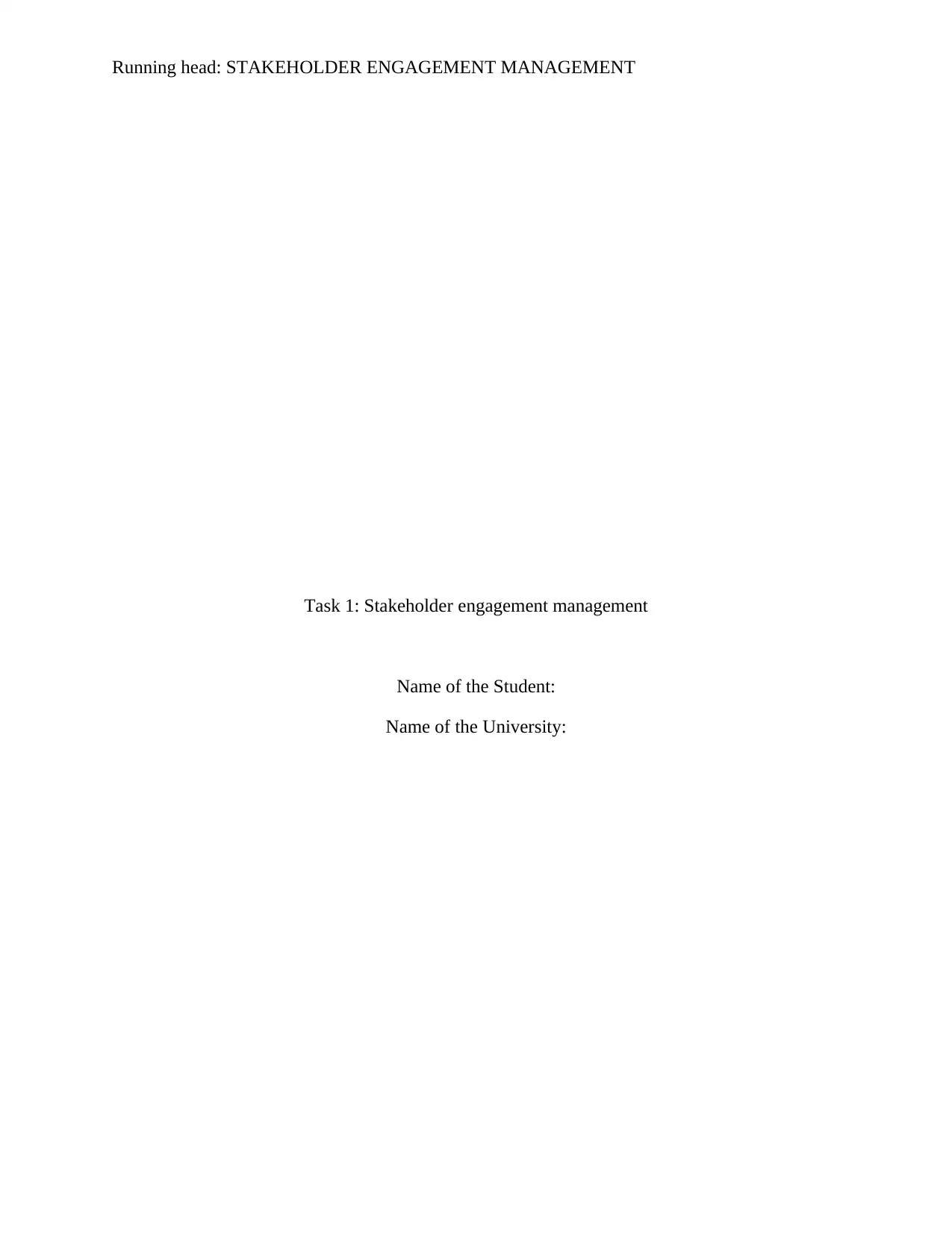
Running head: STAKEHOLDER ENGAGEMENT MANAGEMENT
Task 1: Stakeholder engagement management
Name of the Student:
Name of the University:
Task 1: Stakeholder engagement management
Name of the Student:
Name of the University:
Paraphrase This Document
Need a fresh take? Get an instant paraphrase of this document with our AI Paraphraser
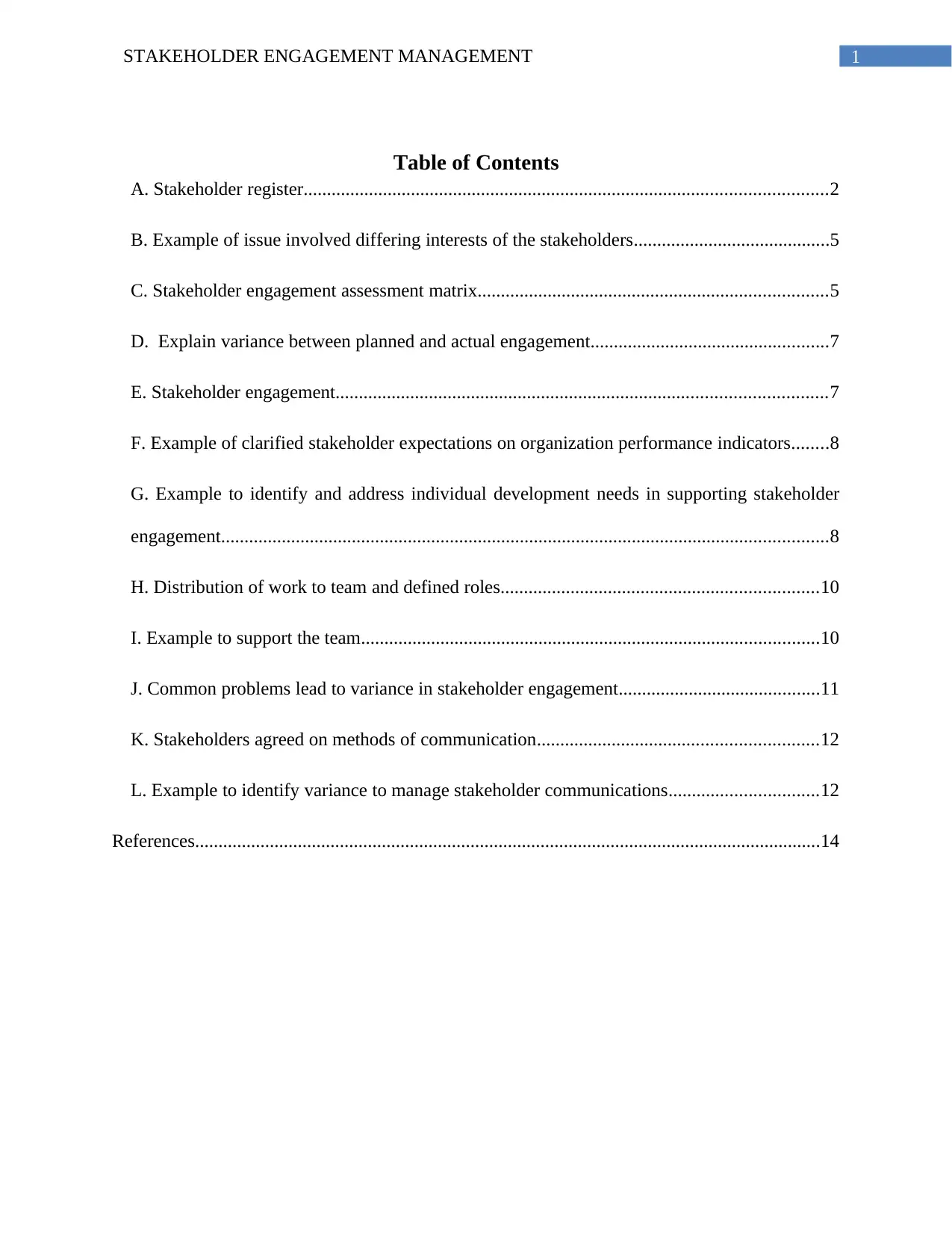
1STAKEHOLDER ENGAGEMENT MANAGEMENT
Table of Contents
A. Stakeholder register................................................................................................................2
B. Example of issue involved differing interests of the stakeholders..........................................5
C. Stakeholder engagement assessment matrix...........................................................................5
D. Explain variance between planned and actual engagement...................................................7
E. Stakeholder engagement.........................................................................................................7
F. Example of clarified stakeholder expectations on organization performance indicators........8
G. Example to identify and address individual development needs in supporting stakeholder
engagement..................................................................................................................................8
H. Distribution of work to team and defined roles....................................................................10
I. Example to support the team..................................................................................................10
J. Common problems lead to variance in stakeholder engagement...........................................11
K. Stakeholders agreed on methods of communication............................................................12
L. Example to identify variance to manage stakeholder communications................................12
References......................................................................................................................................14
Table of Contents
A. Stakeholder register................................................................................................................2
B. Example of issue involved differing interests of the stakeholders..........................................5
C. Stakeholder engagement assessment matrix...........................................................................5
D. Explain variance between planned and actual engagement...................................................7
E. Stakeholder engagement.........................................................................................................7
F. Example of clarified stakeholder expectations on organization performance indicators........8
G. Example to identify and address individual development needs in supporting stakeholder
engagement..................................................................................................................................8
H. Distribution of work to team and defined roles....................................................................10
I. Example to support the team..................................................................................................10
J. Common problems lead to variance in stakeholder engagement...........................................11
K. Stakeholders agreed on methods of communication............................................................12
L. Example to identify variance to manage stakeholder communications................................12
References......................................................................................................................................14
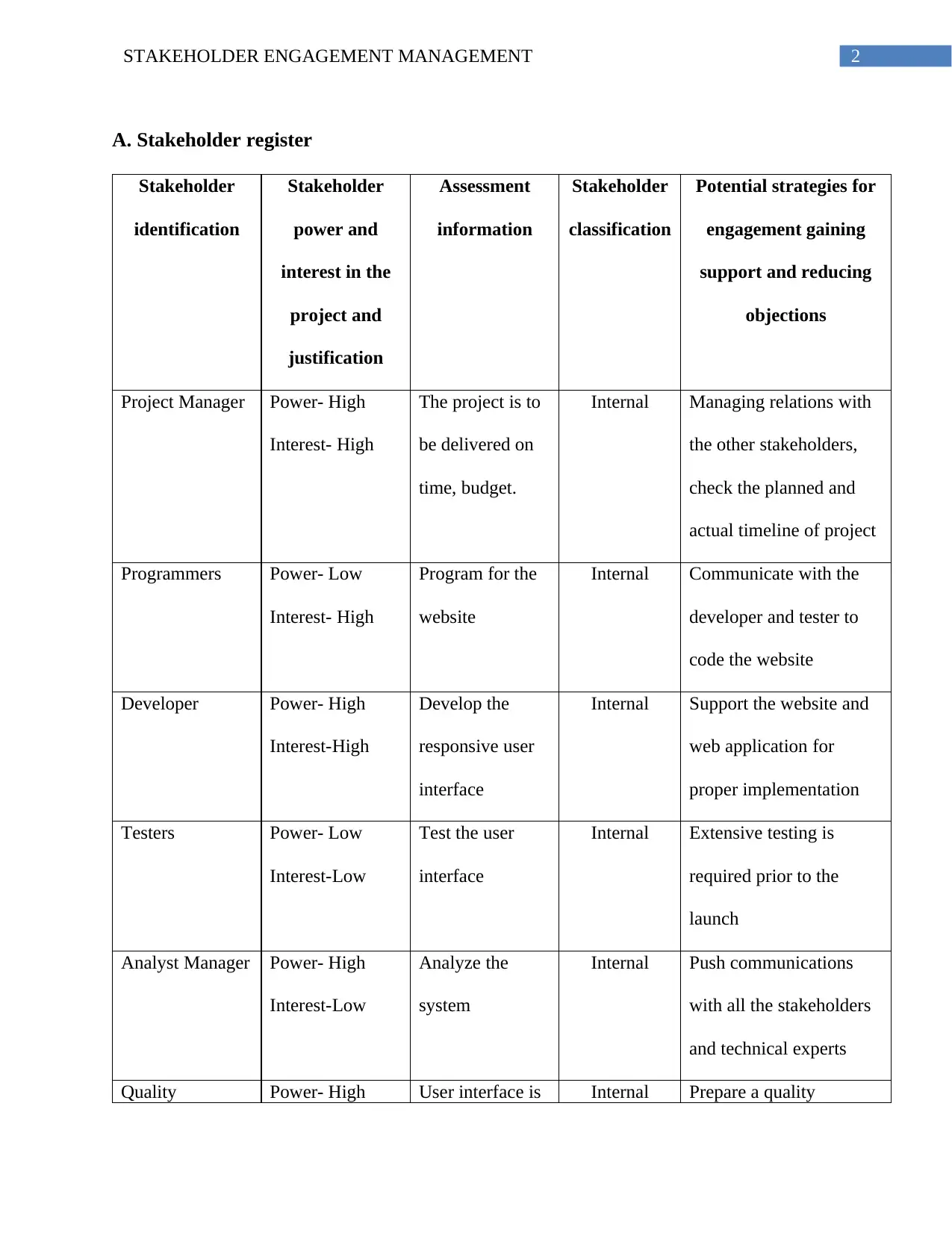
2STAKEHOLDER ENGAGEMENT MANAGEMENT
A. Stakeholder register
Stakeholder
identification
Stakeholder
power and
interest in the
project and
justification
Assessment
information
Stakeholder
classification
Potential strategies for
engagement gaining
support and reducing
objections
Project Manager Power- High
Interest- High
The project is to
be delivered on
time, budget.
Internal Managing relations with
the other stakeholders,
check the planned and
actual timeline of project
Programmers Power- Low
Interest- High
Program for the
website
Internal Communicate with the
developer and tester to
code the website
Developer Power- High
Interest-High
Develop the
responsive user
interface
Internal Support the website and
web application for
proper implementation
Testers Power- Low
Interest-Low
Test the user
interface
Internal Extensive testing is
required prior to the
launch
Analyst Manager Power- High
Interest-Low
Analyze the
system
Internal Push communications
with all the stakeholders
and technical experts
Quality Power- High User interface is Internal Prepare a quality
A. Stakeholder register
Stakeholder
identification
Stakeholder
power and
interest in the
project and
justification
Assessment
information
Stakeholder
classification
Potential strategies for
engagement gaining
support and reducing
objections
Project Manager Power- High
Interest- High
The project is to
be delivered on
time, budget.
Internal Managing relations with
the other stakeholders,
check the planned and
actual timeline of project
Programmers Power- Low
Interest- High
Program for the
website
Internal Communicate with the
developer and tester to
code the website
Developer Power- High
Interest-High
Develop the
responsive user
interface
Internal Support the website and
web application for
proper implementation
Testers Power- Low
Interest-Low
Test the user
interface
Internal Extensive testing is
required prior to the
launch
Analyst Manager Power- High
Interest-Low
Analyze the
system
Internal Push communications
with all the stakeholders
and technical experts
Quality Power- High User interface is Internal Prepare a quality
⊘ This is a preview!⊘
Do you want full access?
Subscribe today to unlock all pages.

Trusted by 1+ million students worldwide
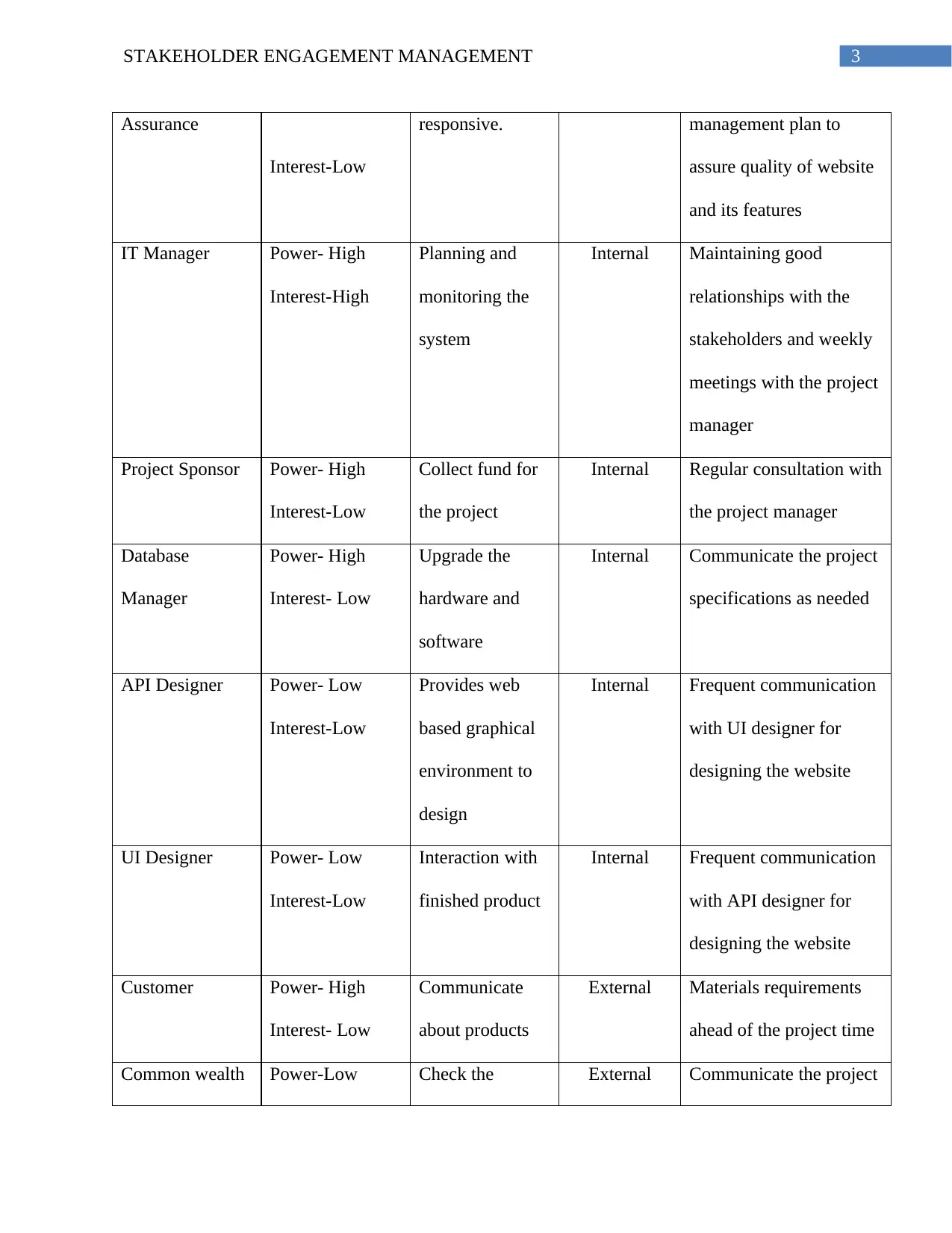
3STAKEHOLDER ENGAGEMENT MANAGEMENT
Assurance
Interest-Low
responsive. management plan to
assure quality of website
and its features
IT Manager Power- High
Interest-High
Planning and
monitoring the
system
Internal Maintaining good
relationships with the
stakeholders and weekly
meetings with the project
manager
Project Sponsor Power- High
Interest-Low
Collect fund for
the project
Internal Regular consultation with
the project manager
Database
Manager
Power- High
Interest- Low
Upgrade the
hardware and
software
Internal Communicate the project
specifications as needed
API Designer Power- Low
Interest-Low
Provides web
based graphical
environment to
design
Internal Frequent communication
with UI designer for
designing the website
UI Designer Power- Low
Interest-Low
Interaction with
finished product
Internal Frequent communication
with API designer for
designing the website
Customer Power- High
Interest- Low
Communicate
about products
External Materials requirements
ahead of the project time
Common wealth Power-Low Check the External Communicate the project
Assurance
Interest-Low
responsive. management plan to
assure quality of website
and its features
IT Manager Power- High
Interest-High
Planning and
monitoring the
system
Internal Maintaining good
relationships with the
stakeholders and weekly
meetings with the project
manager
Project Sponsor Power- High
Interest-Low
Collect fund for
the project
Internal Regular consultation with
the project manager
Database
Manager
Power- High
Interest- Low
Upgrade the
hardware and
software
Internal Communicate the project
specifications as needed
API Designer Power- Low
Interest-Low
Provides web
based graphical
environment to
design
Internal Frequent communication
with UI designer for
designing the website
UI Designer Power- Low
Interest-Low
Interaction with
finished product
Internal Frequent communication
with API designer for
designing the website
Customer Power- High
Interest- Low
Communicate
about products
External Materials requirements
ahead of the project time
Common wealth Power-Low Check the External Communicate the project
Paraphrase This Document
Need a fresh take? Get an instant paraphrase of this document with our AI Paraphraser
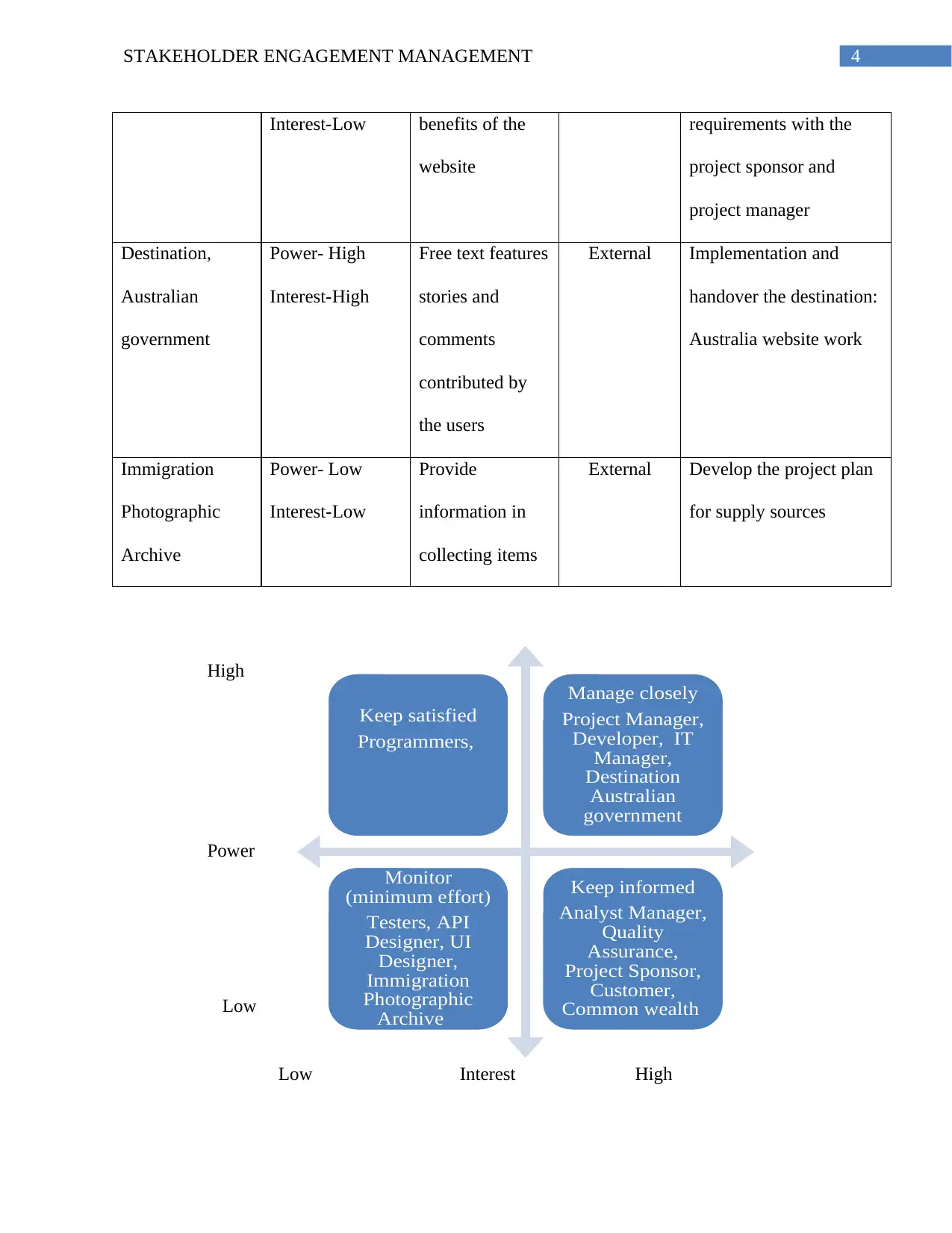
4STAKEHOLDER ENGAGEMENT MANAGEMENT
Interest-Low benefits of the
website
requirements with the
project sponsor and
project manager
Destination,
Australian
government
Power- High
Interest-High
Free text features
stories and
comments
contributed by
the users
External Implementation and
handover the destination:
Australia website work
Immigration
Photographic
Archive
Power- Low
Interest-Low
Provide
information in
collecting items
External Develop the project plan
for supply sources
Keep satisfied
Programmers,
Manage closely
Project Manager,
Developer, IT
Manager,
Destination
Australian
government
Monitor
(minimum effort)
Testers, API
Designer, UI
Designer,
Immigration
Photographic
Archive
Keep informed
Analyst Manager,
Quality
Assurance,
Project Sponsor,
Customer,
Common wealth
Low Interest High
High
Power
Low
Interest-Low benefits of the
website
requirements with the
project sponsor and
project manager
Destination,
Australian
government
Power- High
Interest-High
Free text features
stories and
comments
contributed by
the users
External Implementation and
handover the destination:
Australia website work
Immigration
Photographic
Archive
Power- Low
Interest-Low
Provide
information in
collecting items
External Develop the project plan
for supply sources
Keep satisfied
Programmers,
Manage closely
Project Manager,
Developer, IT
Manager,
Destination
Australian
government
Monitor
(minimum effort)
Testers, API
Designer, UI
Designer,
Immigration
Photographic
Archive
Keep informed
Analyst Manager,
Quality
Assurance,
Project Sponsor,
Customer,
Common wealth
Low Interest High
High
Power
Low
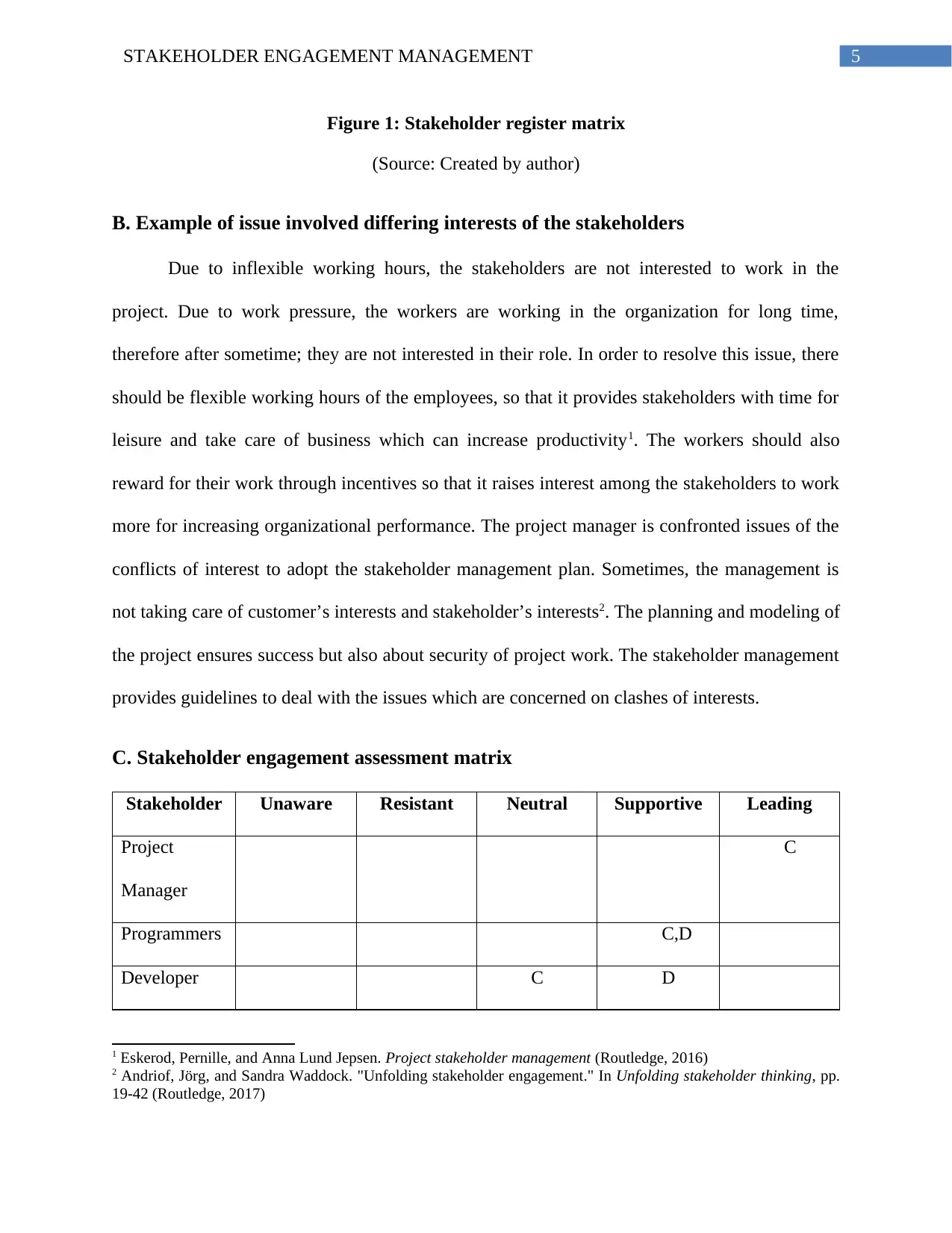
5STAKEHOLDER ENGAGEMENT MANAGEMENT
Figure 1: Stakeholder register matrix
(Source: Created by author)
B. Example of issue involved differing interests of the stakeholders
Due to inflexible working hours, the stakeholders are not interested to work in the
project. Due to work pressure, the workers are working in the organization for long time,
therefore after sometime; they are not interested in their role. In order to resolve this issue, there
should be flexible working hours of the employees, so that it provides stakeholders with time for
leisure and take care of business which can increase productivity1. The workers should also
reward for their work through incentives so that it raises interest among the stakeholders to work
more for increasing organizational performance. The project manager is confronted issues of the
conflicts of interest to adopt the stakeholder management plan. Sometimes, the management is
not taking care of customer’s interests and stakeholder’s interests2. The planning and modeling of
the project ensures success but also about security of project work. The stakeholder management
provides guidelines to deal with the issues which are concerned on clashes of interests.
C. Stakeholder engagement assessment matrix
Stakeholder Unaware Resistant Neutral Supportive Leading
Project
Manager
C
Programmers C,D
Developer C D
1 Eskerod, Pernille, and Anna Lund Jepsen. Project stakeholder management (Routledge, 2016)
2 Andriof, Jörg, and Sandra Waddock. "Unfolding stakeholder engagement." In Unfolding stakeholder thinking, pp.
19-42 (Routledge, 2017)
Figure 1: Stakeholder register matrix
(Source: Created by author)
B. Example of issue involved differing interests of the stakeholders
Due to inflexible working hours, the stakeholders are not interested to work in the
project. Due to work pressure, the workers are working in the organization for long time,
therefore after sometime; they are not interested in their role. In order to resolve this issue, there
should be flexible working hours of the employees, so that it provides stakeholders with time for
leisure and take care of business which can increase productivity1. The workers should also
reward for their work through incentives so that it raises interest among the stakeholders to work
more for increasing organizational performance. The project manager is confronted issues of the
conflicts of interest to adopt the stakeholder management plan. Sometimes, the management is
not taking care of customer’s interests and stakeholder’s interests2. The planning and modeling of
the project ensures success but also about security of project work. The stakeholder management
provides guidelines to deal with the issues which are concerned on clashes of interests.
C. Stakeholder engagement assessment matrix
Stakeholder Unaware Resistant Neutral Supportive Leading
Project
Manager
C
Programmers C,D
Developer C D
1 Eskerod, Pernille, and Anna Lund Jepsen. Project stakeholder management (Routledge, 2016)
2 Andriof, Jörg, and Sandra Waddock. "Unfolding stakeholder engagement." In Unfolding stakeholder thinking, pp.
19-42 (Routledge, 2017)
⊘ This is a preview!⊘
Do you want full access?
Subscribe today to unlock all pages.

Trusted by 1+ million students worldwide
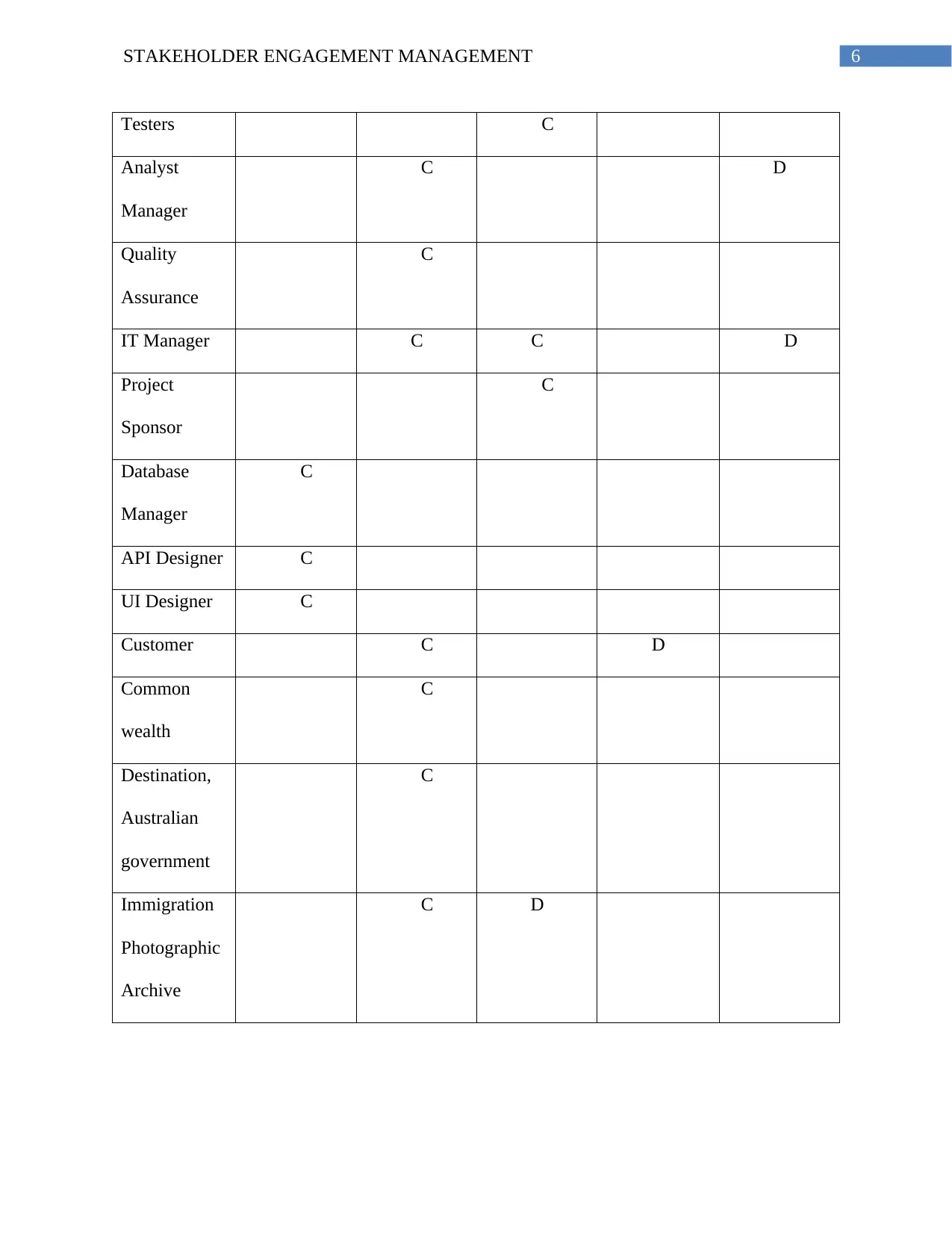
6STAKEHOLDER ENGAGEMENT MANAGEMENT
Testers C
Analyst
Manager
C D
Quality
Assurance
C
IT Manager C C D
Project
Sponsor
C
Database
Manager
C
API Designer C
UI Designer C
Customer C D
Common
wealth
C
Destination,
Australian
government
C
Immigration
Photographic
Archive
C D
Testers C
Analyst
Manager
C D
Quality
Assurance
C
IT Manager C C D
Project
Sponsor
C
Database
Manager
C
API Designer C
UI Designer C
Customer C D
Common
wealth
C
Destination,
Australian
government
C
Immigration
Photographic
Archive
C D
Paraphrase This Document
Need a fresh take? Get an instant paraphrase of this document with our AI Paraphraser
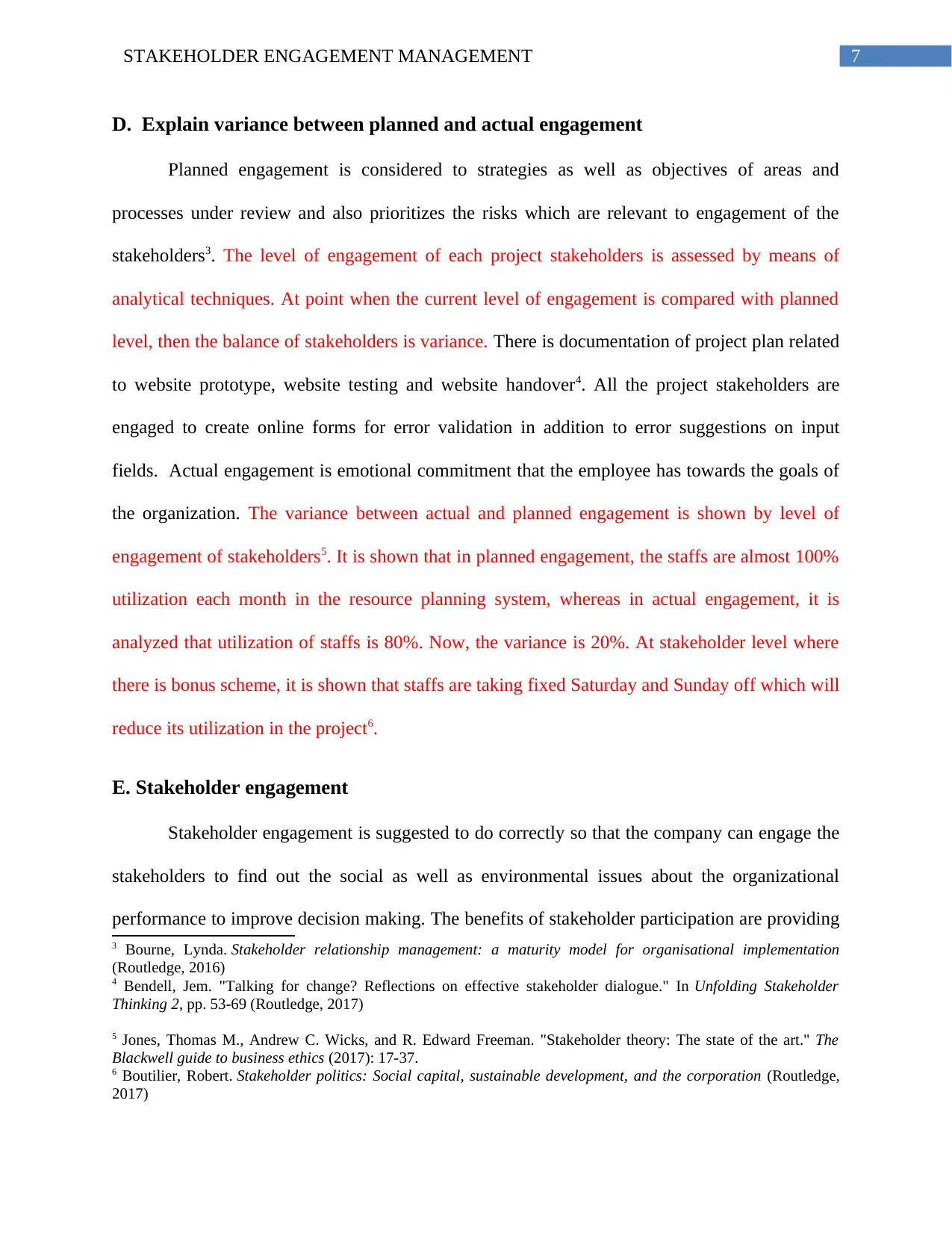
7STAKEHOLDER ENGAGEMENT MANAGEMENT
D. Explain variance between planned and actual engagement
Planned engagement is considered to strategies as well as objectives of areas and
processes under review and also prioritizes the risks which are relevant to engagement of the
stakeholders3. The level of engagement of each project stakeholders is assessed by means of
analytical techniques. At point when the current level of engagement is compared with planned
level, then the balance of stakeholders is variance. There is documentation of project plan related
to website prototype, website testing and website handover4. All the project stakeholders are
engaged to create online forms for error validation in addition to error suggestions on input
fields. Actual engagement is emotional commitment that the employee has towards the goals of
the organization. The variance between actual and planned engagement is shown by level of
engagement of stakeholders5. It is shown that in planned engagement, the staffs are almost 100%
utilization each month in the resource planning system, whereas in actual engagement, it is
analyzed that utilization of staffs is 80%. Now, the variance is 20%. At stakeholder level where
there is bonus scheme, it is shown that staffs are taking fixed Saturday and Sunday off which will
reduce its utilization in the project6.
E. Stakeholder engagement
Stakeholder engagement is suggested to do correctly so that the company can engage the
stakeholders to find out the social as well as environmental issues about the organizational
performance to improve decision making. The benefits of stakeholder participation are providing
3 Bourne, Lynda. Stakeholder relationship management: a maturity model for organisational implementation
(Routledge, 2016)
4 Bendell, Jem. "Talking for change? Reflections on effective stakeholder dialogue." In Unfolding Stakeholder
Thinking 2, pp. 53-69 (Routledge, 2017)
5 Jones, Thomas M., Andrew C. Wicks, and R. Edward Freeman. "Stakeholder theory: The state of the art." The
Blackwell guide to business ethics (2017): 17-37.
6 Boutilier, Robert. Stakeholder politics: Social capital, sustainable development, and the corporation (Routledge,
2017)
D. Explain variance between planned and actual engagement
Planned engagement is considered to strategies as well as objectives of areas and
processes under review and also prioritizes the risks which are relevant to engagement of the
stakeholders3. The level of engagement of each project stakeholders is assessed by means of
analytical techniques. At point when the current level of engagement is compared with planned
level, then the balance of stakeholders is variance. There is documentation of project plan related
to website prototype, website testing and website handover4. All the project stakeholders are
engaged to create online forms for error validation in addition to error suggestions on input
fields. Actual engagement is emotional commitment that the employee has towards the goals of
the organization. The variance between actual and planned engagement is shown by level of
engagement of stakeholders5. It is shown that in planned engagement, the staffs are almost 100%
utilization each month in the resource planning system, whereas in actual engagement, it is
analyzed that utilization of staffs is 80%. Now, the variance is 20%. At stakeholder level where
there is bonus scheme, it is shown that staffs are taking fixed Saturday and Sunday off which will
reduce its utilization in the project6.
E. Stakeholder engagement
Stakeholder engagement is suggested to do correctly so that the company can engage the
stakeholders to find out the social as well as environmental issues about the organizational
performance to improve decision making. The benefits of stakeholder participation are providing
3 Bourne, Lynda. Stakeholder relationship management: a maturity model for organisational implementation
(Routledge, 2016)
4 Bendell, Jem. "Talking for change? Reflections on effective stakeholder dialogue." In Unfolding Stakeholder
Thinking 2, pp. 53-69 (Routledge, 2017)
5 Jones, Thomas M., Andrew C. Wicks, and R. Edward Freeman. "Stakeholder theory: The state of the art." The
Blackwell guide to business ethics (2017): 17-37.
6 Boutilier, Robert. Stakeholder politics: Social capital, sustainable development, and the corporation (Routledge,
2017)
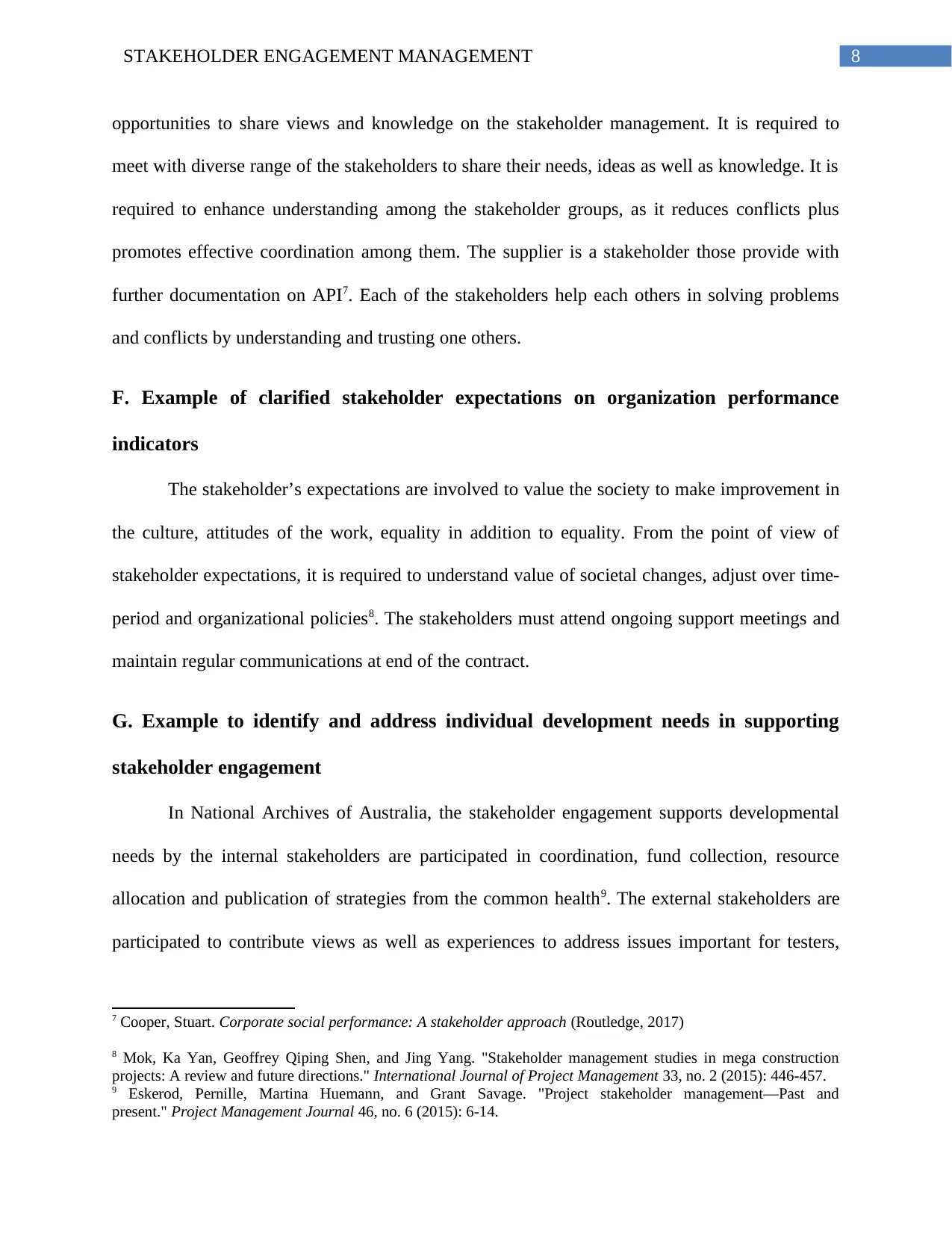
8STAKEHOLDER ENGAGEMENT MANAGEMENT
opportunities to share views and knowledge on the stakeholder management. It is required to
meet with diverse range of the stakeholders to share their needs, ideas as well as knowledge. It is
required to enhance understanding among the stakeholder groups, as it reduces conflicts plus
promotes effective coordination among them. The supplier is a stakeholder those provide with
further documentation on API7. Each of the stakeholders help each others in solving problems
and conflicts by understanding and trusting one others.
F. Example of clarified stakeholder expectations on organization performance
indicators
The stakeholder’s expectations are involved to value the society to make improvement in
the culture, attitudes of the work, equality in addition to equality. From the point of view of
stakeholder expectations, it is required to understand value of societal changes, adjust over time-
period and organizational policies8. The stakeholders must attend ongoing support meetings and
maintain regular communications at end of the contract.
G. Example to identify and address individual development needs in supporting
stakeholder engagement
In National Archives of Australia, the stakeholder engagement supports developmental
needs by the internal stakeholders are participated in coordination, fund collection, resource
allocation and publication of strategies from the common health9. The external stakeholders are
participated to contribute views as well as experiences to address issues important for testers,
7 Cooper, Stuart. Corporate social performance: A stakeholder approach (Routledge, 2017)
8 Mok, Ka Yan, Geoffrey Qiping Shen, and Jing Yang. "Stakeholder management studies in mega construction
projects: A review and future directions." International Journal of Project Management 33, no. 2 (2015): 446-457.
9 Eskerod, Pernille, Martina Huemann, and Grant Savage. "Project stakeholder management—Past and
present." Project Management Journal 46, no. 6 (2015): 6-14.
opportunities to share views and knowledge on the stakeholder management. It is required to
meet with diverse range of the stakeholders to share their needs, ideas as well as knowledge. It is
required to enhance understanding among the stakeholder groups, as it reduces conflicts plus
promotes effective coordination among them. The supplier is a stakeholder those provide with
further documentation on API7. Each of the stakeholders help each others in solving problems
and conflicts by understanding and trusting one others.
F. Example of clarified stakeholder expectations on organization performance
indicators
The stakeholder’s expectations are involved to value the society to make improvement in
the culture, attitudes of the work, equality in addition to equality. From the point of view of
stakeholder expectations, it is required to understand value of societal changes, adjust over time-
period and organizational policies8. The stakeholders must attend ongoing support meetings and
maintain regular communications at end of the contract.
G. Example to identify and address individual development needs in supporting
stakeholder engagement
In National Archives of Australia, the stakeholder engagement supports developmental
needs by the internal stakeholders are participated in coordination, fund collection, resource
allocation and publication of strategies from the common health9. The external stakeholders are
participated to contribute views as well as experiences to address issues important for testers,
7 Cooper, Stuart. Corporate social performance: A stakeholder approach (Routledge, 2017)
8 Mok, Ka Yan, Geoffrey Qiping Shen, and Jing Yang. "Stakeholder management studies in mega construction
projects: A review and future directions." International Journal of Project Management 33, no. 2 (2015): 446-457.
9 Eskerod, Pernille, Martina Huemann, and Grant Savage. "Project stakeholder management—Past and
present." Project Management Journal 46, no. 6 (2015): 6-14.
⊘ This is a preview!⊘
Do you want full access?
Subscribe today to unlock all pages.

Trusted by 1+ million students worldwide
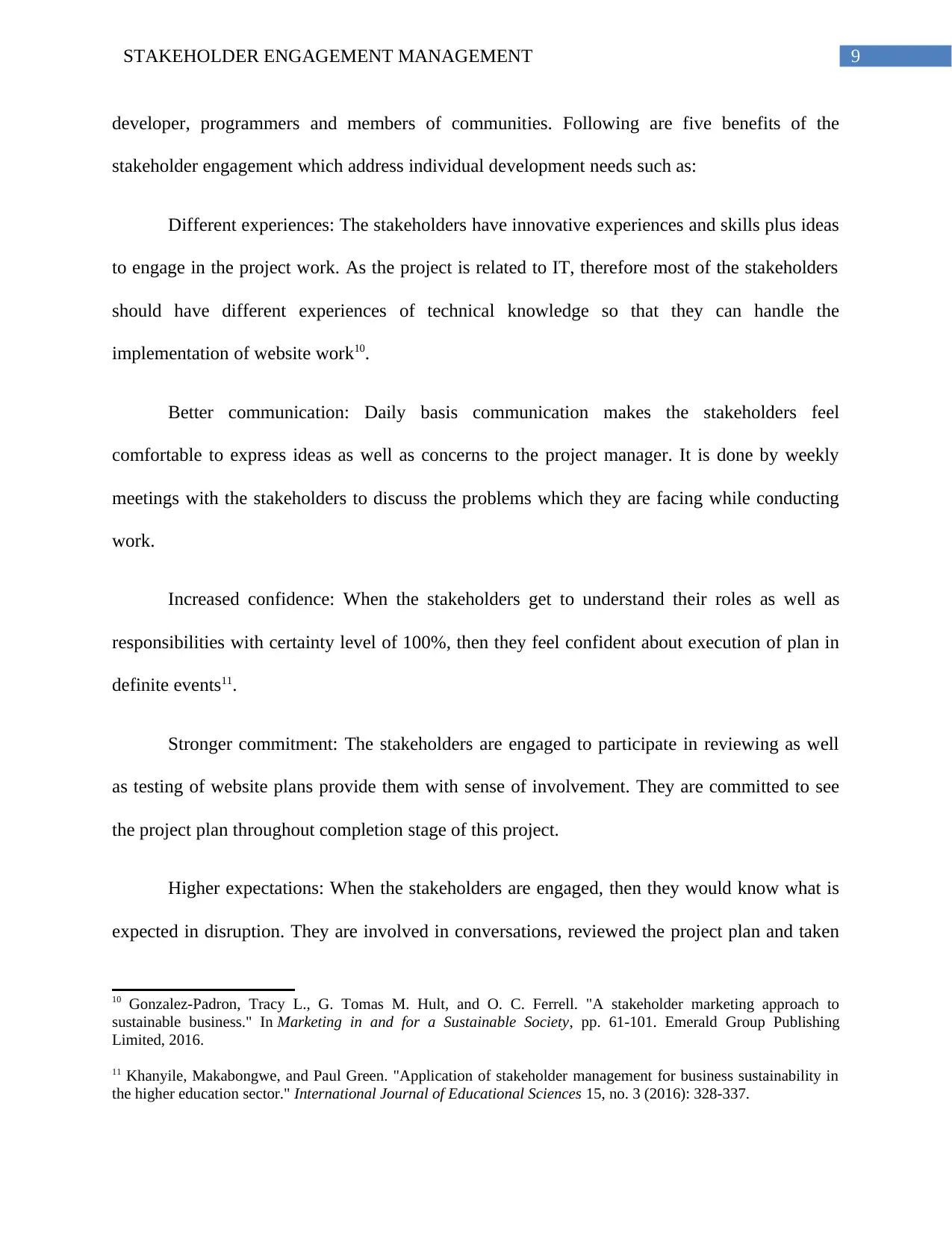
9STAKEHOLDER ENGAGEMENT MANAGEMENT
developer, programmers and members of communities. Following are five benefits of the
stakeholder engagement which address individual development needs such as:
Different experiences: The stakeholders have innovative experiences and skills plus ideas
to engage in the project work. As the project is related to IT, therefore most of the stakeholders
should have different experiences of technical knowledge so that they can handle the
implementation of website work10.
Better communication: Daily basis communication makes the stakeholders feel
comfortable to express ideas as well as concerns to the project manager. It is done by weekly
meetings with the stakeholders to discuss the problems which they are facing while conducting
work.
Increased confidence: When the stakeholders get to understand their roles as well as
responsibilities with certainty level of 100%, then they feel confident about execution of plan in
definite events11.
Stronger commitment: The stakeholders are engaged to participate in reviewing as well
as testing of website plans provide them with sense of involvement. They are committed to see
the project plan throughout completion stage of this project.
Higher expectations: When the stakeholders are engaged, then they would know what is
expected in disruption. They are involved in conversations, reviewed the project plan and taken
10 Gonzalez-Padron, Tracy L., G. Tomas M. Hult, and O. C. Ferrell. "A stakeholder marketing approach to
sustainable business." In Marketing in and for a Sustainable Society, pp. 61-101. Emerald Group Publishing
Limited, 2016.
11 Khanyile, Makabongwe, and Paul Green. "Application of stakeholder management for business sustainability in
the higher education sector." International Journal of Educational Sciences 15, no. 3 (2016): 328-337.
developer, programmers and members of communities. Following are five benefits of the
stakeholder engagement which address individual development needs such as:
Different experiences: The stakeholders have innovative experiences and skills plus ideas
to engage in the project work. As the project is related to IT, therefore most of the stakeholders
should have different experiences of technical knowledge so that they can handle the
implementation of website work10.
Better communication: Daily basis communication makes the stakeholders feel
comfortable to express ideas as well as concerns to the project manager. It is done by weekly
meetings with the stakeholders to discuss the problems which they are facing while conducting
work.
Increased confidence: When the stakeholders get to understand their roles as well as
responsibilities with certainty level of 100%, then they feel confident about execution of plan in
definite events11.
Stronger commitment: The stakeholders are engaged to participate in reviewing as well
as testing of website plans provide them with sense of involvement. They are committed to see
the project plan throughout completion stage of this project.
Higher expectations: When the stakeholders are engaged, then they would know what is
expected in disruption. They are involved in conversations, reviewed the project plan and taken
10 Gonzalez-Padron, Tracy L., G. Tomas M. Hult, and O. C. Ferrell. "A stakeholder marketing approach to
sustainable business." In Marketing in and for a Sustainable Society, pp. 61-101. Emerald Group Publishing
Limited, 2016.
11 Khanyile, Makabongwe, and Paul Green. "Application of stakeholder management for business sustainability in
the higher education sector." International Journal of Educational Sciences 15, no. 3 (2016): 328-337.
Paraphrase This Document
Need a fresh take? Get an instant paraphrase of this document with our AI Paraphraser
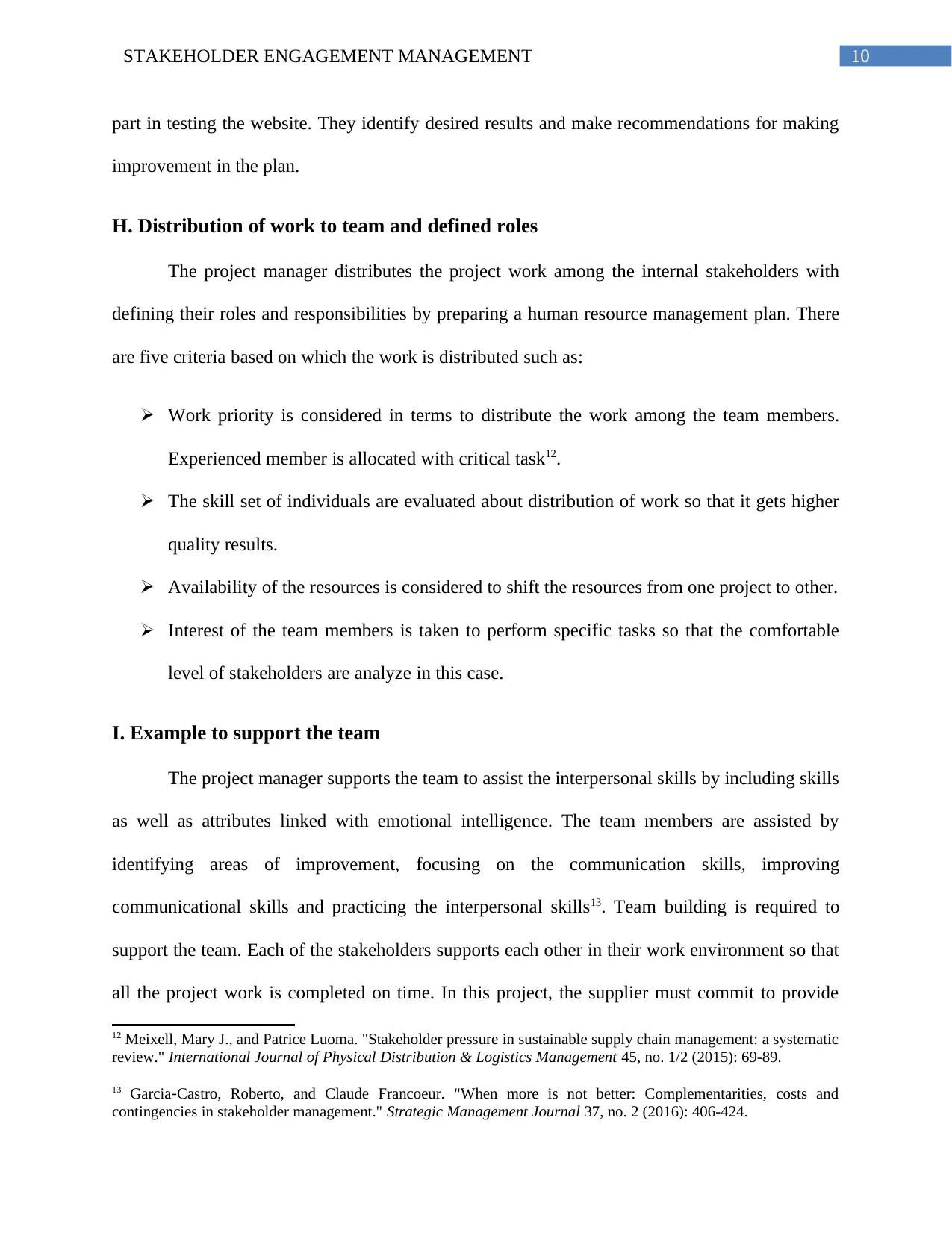
10STAKEHOLDER ENGAGEMENT MANAGEMENT
part in testing the website. They identify desired results and make recommendations for making
improvement in the plan.
H. Distribution of work to team and defined roles
The project manager distributes the project work among the internal stakeholders with
defining their roles and responsibilities by preparing a human resource management plan. There
are five criteria based on which the work is distributed such as:
Work priority is considered in terms to distribute the work among the team members.
Experienced member is allocated with critical task12.
The skill set of individuals are evaluated about distribution of work so that it gets higher
quality results.
Availability of the resources is considered to shift the resources from one project to other.
Interest of the team members is taken to perform specific tasks so that the comfortable
level of stakeholders are analyze in this case.
I. Example to support the team
The project manager supports the team to assist the interpersonal skills by including skills
as well as attributes linked with emotional intelligence. The team members are assisted by
identifying areas of improvement, focusing on the communication skills, improving
communicational skills and practicing the interpersonal skills13. Team building is required to
support the team. Each of the stakeholders supports each other in their work environment so that
all the project work is completed on time. In this project, the supplier must commit to provide
12 Meixell, Mary J., and Patrice Luoma. "Stakeholder pressure in sustainable supply chain management: a systematic
review." International Journal of Physical Distribution & Logistics Management 45, no. 1/2 (2015): 69-89.
13 Garcia‐Castro, Roberto, and Claude Francoeur. "When more is not better: Complementarities, costs and
contingencies in stakeholder management." Strategic Management Journal 37, no. 2 (2016): 406-424.
part in testing the website. They identify desired results and make recommendations for making
improvement in the plan.
H. Distribution of work to team and defined roles
The project manager distributes the project work among the internal stakeholders with
defining their roles and responsibilities by preparing a human resource management plan. There
are five criteria based on which the work is distributed such as:
Work priority is considered in terms to distribute the work among the team members.
Experienced member is allocated with critical task12.
The skill set of individuals are evaluated about distribution of work so that it gets higher
quality results.
Availability of the resources is considered to shift the resources from one project to other.
Interest of the team members is taken to perform specific tasks so that the comfortable
level of stakeholders are analyze in this case.
I. Example to support the team
The project manager supports the team to assist the interpersonal skills by including skills
as well as attributes linked with emotional intelligence. The team members are assisted by
identifying areas of improvement, focusing on the communication skills, improving
communicational skills and practicing the interpersonal skills13. Team building is required to
support the team. Each of the stakeholders supports each other in their work environment so that
all the project work is completed on time. In this project, the supplier must commit to provide
12 Meixell, Mary J., and Patrice Luoma. "Stakeholder pressure in sustainable supply chain management: a systematic
review." International Journal of Physical Distribution & Logistics Management 45, no. 1/2 (2015): 69-89.
13 Garcia‐Castro, Roberto, and Claude Francoeur. "When more is not better: Complementarities, costs and
contingencies in stakeholder management." Strategic Management Journal 37, no. 2 (2016): 406-424.
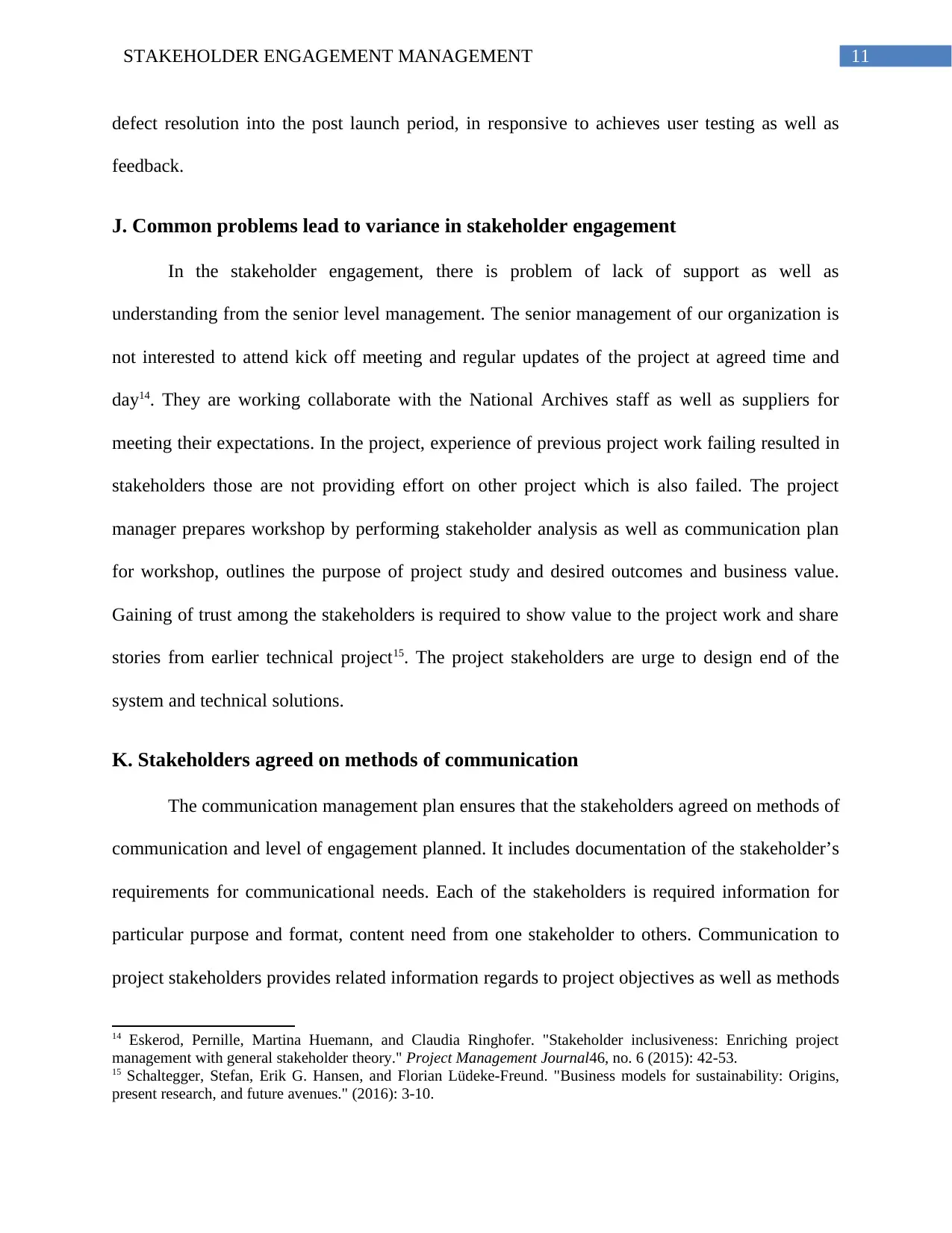
11STAKEHOLDER ENGAGEMENT MANAGEMENT
defect resolution into the post launch period, in responsive to achieves user testing as well as
feedback.
J. Common problems lead to variance in stakeholder engagement
In the stakeholder engagement, there is problem of lack of support as well as
understanding from the senior level management. The senior management of our organization is
not interested to attend kick off meeting and regular updates of the project at agreed time and
day14. They are working collaborate with the National Archives staff as well as suppliers for
meeting their expectations. In the project, experience of previous project work failing resulted in
stakeholders those are not providing effort on other project which is also failed. The project
manager prepares workshop by performing stakeholder analysis as well as communication plan
for workshop, outlines the purpose of project study and desired outcomes and business value.
Gaining of trust among the stakeholders is required to show value to the project work and share
stories from earlier technical project15. The project stakeholders are urge to design end of the
system and technical solutions.
K. Stakeholders agreed on methods of communication
The communication management plan ensures that the stakeholders agreed on methods of
communication and level of engagement planned. It includes documentation of the stakeholder’s
requirements for communicational needs. Each of the stakeholders is required information for
particular purpose and format, content need from one stakeholder to others. Communication to
project stakeholders provides related information regards to project objectives as well as methods
14 Eskerod, Pernille, Martina Huemann, and Claudia Ringhofer. "Stakeholder inclusiveness: Enriching project
management with general stakeholder theory." Project Management Journal46, no. 6 (2015): 42-53.
15 Schaltegger, Stefan, Erik G. Hansen, and Florian Lüdeke-Freund. "Business models for sustainability: Origins,
present research, and future avenues." (2016): 3-10.
defect resolution into the post launch period, in responsive to achieves user testing as well as
feedback.
J. Common problems lead to variance in stakeholder engagement
In the stakeholder engagement, there is problem of lack of support as well as
understanding from the senior level management. The senior management of our organization is
not interested to attend kick off meeting and regular updates of the project at agreed time and
day14. They are working collaborate with the National Archives staff as well as suppliers for
meeting their expectations. In the project, experience of previous project work failing resulted in
stakeholders those are not providing effort on other project which is also failed. The project
manager prepares workshop by performing stakeholder analysis as well as communication plan
for workshop, outlines the purpose of project study and desired outcomes and business value.
Gaining of trust among the stakeholders is required to show value to the project work and share
stories from earlier technical project15. The project stakeholders are urge to design end of the
system and technical solutions.
K. Stakeholders agreed on methods of communication
The communication management plan ensures that the stakeholders agreed on methods of
communication and level of engagement planned. It includes documentation of the stakeholder’s
requirements for communicational needs. Each of the stakeholders is required information for
particular purpose and format, content need from one stakeholder to others. Communication to
project stakeholders provides related information regards to project objectives as well as methods
14 Eskerod, Pernille, Martina Huemann, and Claudia Ringhofer. "Stakeholder inclusiveness: Enriching project
management with general stakeholder theory." Project Management Journal46, no. 6 (2015): 42-53.
15 Schaltegger, Stefan, Erik G. Hansen, and Florian Lüdeke-Freund. "Business models for sustainability: Origins,
present research, and future avenues." (2016): 3-10.
⊘ This is a preview!⊘
Do you want full access?
Subscribe today to unlock all pages.

Trusted by 1+ million students worldwide
1 out of 16
Related Documents
Your All-in-One AI-Powered Toolkit for Academic Success.
+13062052269
info@desklib.com
Available 24*7 on WhatsApp / Email
![[object Object]](/_next/static/media/star-bottom.7253800d.svg)
Unlock your academic potential
Copyright © 2020–2025 A2Z Services. All Rights Reserved. Developed and managed by ZUCOL.




